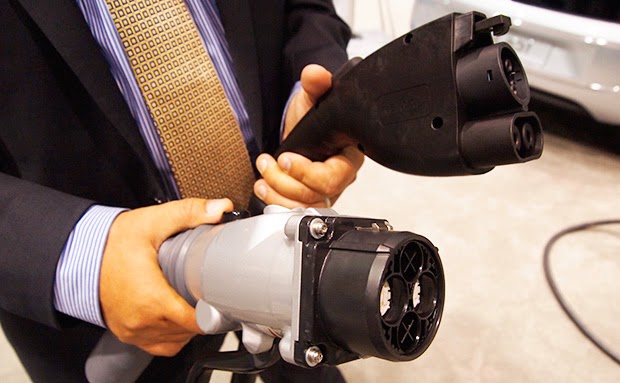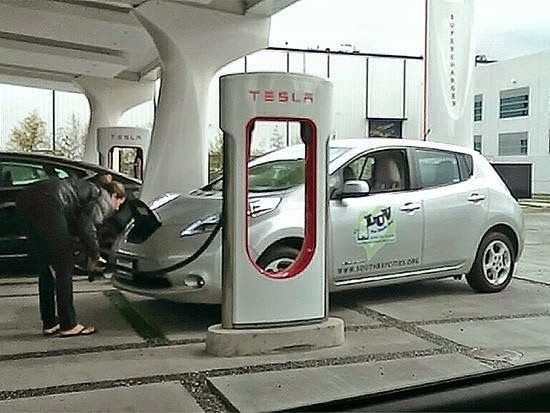Why should Tesla Model S owners be the only EV owners capable of taking long distant trips? What’s needed is fast charging infrastructure located along highways between major cities supporting cars other than Tesla’s. Existing DCFC infrastructure for the rest of us is only been located inside cities, and not between cities (with few exceptions). For example, by my calculation driving a CHAdeMO vehicle like my Kia Soul EV from the SF Bay Area to Los Angeles is possible, but the trip would require 18 hours because the first CHAdeMO station is in Santa Barbara.
Today an announcement from BMW, Volkswagen and ChargePoint aims to change all that. The companies are teaming up to deploy a DC Fast Charging network along corridors between major cities on the East Coast and West Coast.
In essence it would take the “West Coast Electric Highway” concept, extending it beyond Oregon and Washington State.

![]()
The plan is to install about 100 DC Fast Charging stations, for a start, then expand it later, it seems. The relevant sentence in the press release isn’t quite worded well, but it makes sense they wouldn’t stop at 100 stations. Tesla Motors is certainly demonstrating the large number of fast charging stations required to cover the country.
The regions to start with are:
East Coast: the I-95 corridor between Washington DC and Boston,
West Coast: the metropolitan areas stretching from San Diego to Portland. (sounds like the I-5 corridor)
West Coast locations are already being installed, with one having already been built in San Diego. They expect to use convenient locations such restaurants, shopping centers, rest stops, and more
There will be two kinds of installations – 50 kW stations and 24 kW stations. The latter will be the BMW-designed units unveiled last summer.
Let’s get to the pink elephant standing here which the press release does not cover: CHAdeMO.
Since it is BMW and VW teaming up with ChargePoint, all the verbiage in the press release and the accompanying pictures show the BMW i3, VW e-Golf, and ComboCharging System charging ports. The question is whether they’ll ignore CHAdeMO and build CCS-only infrastructure.
According to ChargePoint, the answer to that depends on the charging equipment at each location.
The 24 kW stations, which will be located in “towns … away from the main corridors”, will only support the Combo Charging System. That’s because the 24 kW units are the ones designed by BMW, which can only support CCS.
The 50 kW stations are what will be installed on the primary highway corridors. These will be hardware which supports multiple charge cords, probably ABB’s charging stations. Meaning, that the 50 kW stations will be capable of supporting CHAdeMO.
That means a glimmer of a possibility that the infrastructure will support CHAdeMO. But we shouldn’t take it as a given until the hardware starts being built.
The problem is the long standing battle over DC Fast Charging standards. Where the industry settled on a common level 2 charging protocol, there are several fast charging standards![]() . CHAdeMO is the most widely deployed, has the largest number of compatible EV’s in the field, and is adopted primarily by the Japanese EV makers. Tesla’s SuperCharger is adopted only by Tesla Motors, and the company is building out stations across North America, Europe, China and Australia (so far). The Combo Charging System was standardized by the SAE, is largely adopted by the German and U.S. EV makers, and has so far seen little deployment and there aren’t many CCS-compatible cars in the field.
. CHAdeMO is the most widely deployed, has the largest number of compatible EV’s in the field, and is adopted primarily by the Japanese EV makers. Tesla’s SuperCharger is adopted only by Tesla Motors, and the company is building out stations across North America, Europe, China and Australia (so far). The Combo Charging System was standardized by the SAE, is largely adopted by the German and U.S. EV makers, and has so far seen little deployment and there aren’t many CCS-compatible cars in the field.
As VW, BMW and other car makers finally get around to selling CCS-compatible cars we expect the market numbers to tilt to CCS. Maybe. Depends on a lot of factors.
Because of these battling fast charging standards, the DC Fast Charging infrastructure isn’t as useful as it could be. An EV owner cannot just go to any fast charging station, they have to understand the difference between different charging cords, and choose the correct station for their car.
The disunity between CHAdeMO and CCS had been somewhat acceptable because ABB and other charging station makers have designed dual-protocol units. That meant an EV owner can drive up to a fast charging station and use the appropriate cord.
But – if BMW and VW don’t allow CHAdeMO cords on the 50 kW stations, the EV owners won’t have the flexibility of being able to use the appropriate cord because it simply won’t be there.
This move by BMW and VW, to make it CCS-preferenced infrastructure, doesn’t help the overall problem. Rather than reducing the number of fast charging systems on the market, it cements the current situation of competing standards in which EV owners lose.
- Highway design could decrease death and injury risk, if “we” chose smarter designs - March 28, 2015
- GM really did trademark “range anxiety”, only later to abandon that mark - March 25, 2015
- US Government releases new regulations on hydraulic fracturing, that some call “toothless” - March 20, 2015
- Tesla Motors magic pill to solve range anxiety doesn’t quite instill range confidence - March 19, 2015
- Update on Galena IL oil train – 21 cars involved, which were the supposedly safer CP1232 design - March 7, 2015
- Another oil bomb train – why are they shipping crude oil by train? – Symptoms of fossil fuel addiction - March 6, 2015
- Chevron relinquishes fracking in Romania, as part of broader pull-out from Eastern European fracking operations - February 22, 2015
- Answer anti- electric car articles with truth and pride – truth outshines all distortions - February 19, 2015
- Apple taking big risk on developing a car? Please, Apple, don’t go there! - February 16, 2015
- Toyota, Nissan, Honda working on Japanese fuel cell infrastructure for Japanese government - February 12, 2015
























Pingback: ChargePoint starting to fulfill promised West Coast fast charging network | The Long Tail Pipe
Pingback: ChargePoint’s host site sales pitch, and the charging station infrastructure that doesn’t quite serve us | The Long Tail Pipe